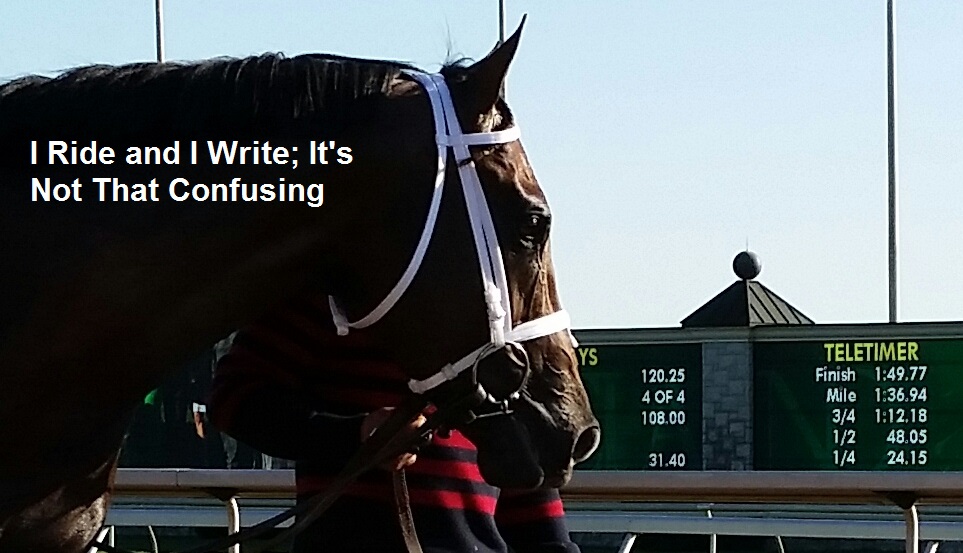If you read the title
and thought “regaining confidence” was about Bella, I’ll let you know that
Bella is still full of herself and feeling great. She enjoys having the
attention of the horses she is turned out with and has an extra boost of energy
with the onset of cold weather.
Bella thinks she is a fire breathing dragon. This was after Saturday's ride.
This blog post is
actually going to be more about me trying to regain some of the confidence I
lost in my riding abilities. To be honest, it’s probably going to end with how
awesome my horse is and how she takes care of me, etc.
So here goes.
Most Saturday mornings
I am out at the barn with Bella. Yesterday was just one of those days where I
did not feel like tacking up. Instead, I hopped on bareback with a rope and
halter. Bella is still learning how to guide without a bit, but she’s picked it
up pretty well. However, if something catches her eye and she wants to go a
different direction she “forgets” what guiding is.
Back when Bella was in
training as a show horse, she would get the winters off for vacation. The last couple
winters I finally became brave enough to hop on her bareback, but with a
bridle. I used to only walk and canter because of her quick step trotting, but
I gradually worked my way into trotting on her bareback too. When doing so
every weekend, I became much more confident on her and got a lot stronger as a
rider. Even when she was full of energy, it didn’t faze me to hop on bareback
and go around at a show trot.
Riding bareback with confidence late in 2014.
When I pulled her out
of the stall yesterday, I could tell she was feeling frisky. I had made my
decision to go bareback with a rope and halter and I wanted to see it through,
to show myself I could do it, but the nerves got to me when I climbed on.
Bella never took off,
but she did have a bounce to her step. I held onto her mane (or what we
equestrians sometimes call an “Oh, shit!” handle) so hard that my hand was
cramping. The energy she had made me nervous. I had been on her bareback with a
rope and halter over summer, but that’s when the heat had zapped everyone’s
energy.
Now in the cold on a
frisky mare, I was nervous. At the end of my junior year in college, I picked
up a second job while heading into finals and projects. I didn’t take lessons
for about two months, and only slowly got back into them over summer.
There were times I
would ride and I felt out of shape. My endurance in the saddle was not what it
used to be. A few weeks ago I even said, “I feel like a washed up, out of
shape, adult amateur.”
So there I was, sitting
on Bella bareback, holding on for dear life and afraid to do more than walk.
Andrew was at the barn with me, and with some reassurance from him I finally
did trot and canter.
Bella didn’t run off with
me, she stopped when asked, and I didn’t fall off. Instead of keeping my legs
frozen in place to grip, I began to relax and used them to help guide Bella
around the turns of the indoor arena, which is a pretty nice aid when you have
no bit.
No bit? No problem. Getting confidence back in yesterday's ride.
As I trotted and
cantered, I began to feel more confident in my ability. I wasn’t at my peak,
but I rode around just fine. I even posted above Bella’s tall withers without a
problem.
There’s been times when
I haven’t put the effort in to get my riding back on track to where it was. I
was frustrated with myself and sometimes slightly embarrassed. I now realize
it’s okay if we lose ourselves. It doesn’t matter how good of a rider you are;
it matters if you push through your challenges.
I think I want to spend
more time this winter bareback on my frisky mare. I need to not only trust the
horse who has never brought me harm while on her back, but I need to trust
myself too.
Thanks to my readers
for letting me ramble, thanks to my friends and instructors for supporting me
through the years, and most of all, a big thank you to Bella for continuously
teaching me for more than nine years. I owe her the world.



















































